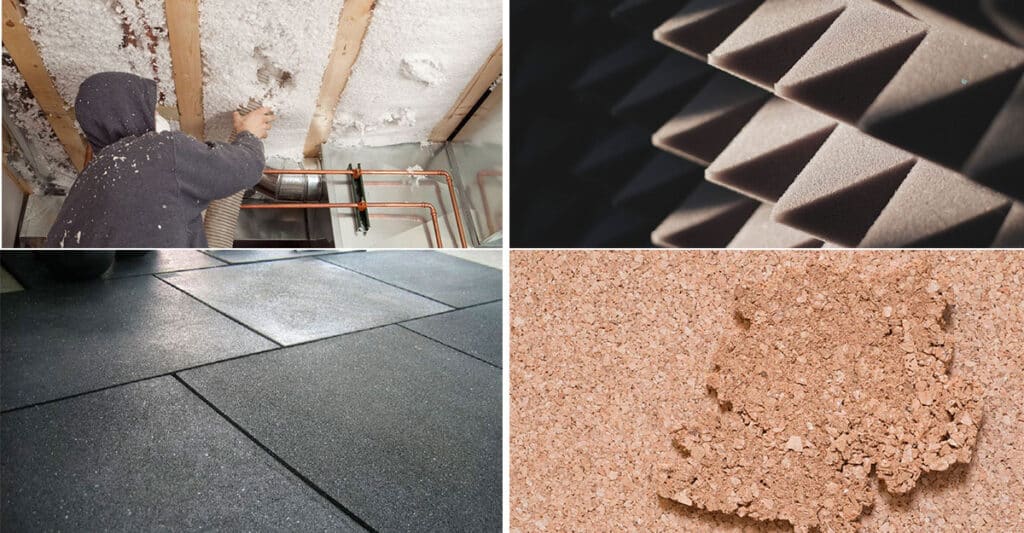Introduction
The amount of noise generated in a busy gym is considerable. The culprits? Dumbbells or barbells hitting the ground, weights colliding with each other violently, and simply customers talking loudly during peak hours. Whatever the reason, excessive noise can lead to problems with neighbours and even trouble between members. How can I soundproof my gym? So are there measures we can take to eliminate or reduce the noise in a gym?
The answer is yes. Throughout this article, we’ll look at how you can soundproof floors, walls and ceilings in your facility. Each surface requires a different approach. Plus, we’ll cover the most effective ways to reduce the noise produced by equipment like dumbbells and cardio machines.
Soundproofing Floors
Let’s start with the hardest-hit surface in any fitness centre: the gym floor. It may not be necessary to use soundproofing materials throughout the centre. It is, however, a sensible idea to protect the areas where dumbbells and barbells will be used by installing a flooring material capable of absorbing much of the sound.
Specifically, we are talking about rubber flooring at least 2 cm thick. This material comes in practical tile sizes of 100 cm x 100 cm, 50 cm x 50 cm, and smaller puzzle-type modules.
If you seek further cushioning for deadlifts or similar heavy-weight impacts, you can increase the thickness of the rubber up to 5 cm to limit the resulting noise more effectively. Another viable option is to create a designated deadlift platform. This way, you wouldn’t have to increase the thickness of the flooring throughout the gym.

Soundproofing Walls
Inadequately thin walls are much more common than we might think. They can complicate the task of soundproofing since it’s rarely within our means to undertake construction work to solve the problem. However, there is a solution.
Similar to the flooring solution, we can install adhesive acoustic panels on the walls of the gym to significantly reduce noise. Polyurethane foam panels (also called copopren) are an inexpensive but highly effective material for soundproofing. Thickness ranges up to 4 cm and is available in rolls or individual panels, the length and width of which are dependent on specific requirements.
Conversely, if the layout of your gym won’t accommodate the installation of panels, all is not lost. If, for example, a spinning room is separated from the rest of the gym by a simple partition, a solution could be to investigate an acoustic laminated glass or even an air chamber.
Soundproofing Ceiling
So far, we’ve discussed the options available to reduce noise inside the gym, but what about our neighbours? If you are in a city, your premises are likely on the ground floor. If so, it’s vital to reduce the annoying noise likely to affect the upper floors as much as possible.
In this case, the same economic solution for the walls applies here: installation of polyurethane foam. However, sometimes this may not be enough. If budget allows, in addition to surface soundproofing, installing a false ceiling would provide a double function: a space to hide unsightly wiring and an air chamber that further absorbs noise.
If constructing a false ceiling proves too much of a budgetary and logistical headache, stick with an acoustic covering of polyurethane foam plates. They are a faster, cheaper alternative that will provide adequate soundproofing in most gym environments.
Equipment Soundproofing
Without a doubt, the most annoying noises in any gym come from the weights. If it’s dumbbells hitting the ground or the weight stack on the leg press, here are the most effective ways to minimise this problem.
First, rubber-coated dumbbells. In addition to their main advantage – the minimal noise they generate – they also have superior longevity due to the durability of the coating, which prevents oxidation of the internal metal plate. Optionally, there are weights made entirely of rubber.
As for weight machines and their pesky weights clattering into each other, the solution is so easy it’s hard to believe. Simply attach small strips of cushioning material between each weight (please note: this is infinitely easier before assembling the machine!). This way, it won’t make such a racket when the user decides to dump their set.
Finally, we cannot overlook the acoustic impact of treadmills, ellipticals, and spinning bikes. Most commercial gyms have a vast and varied cardio section. It’s a good idea to use rubber flooring in the cardio area. If this seems extreme or outside your budget, you can use anti-vibration pads on the corners of each machine. To further reduce the noise generated by cardio machines, prioritise good maintenance practices by keeping them well-oiled and dust free.
Summary
Whatever your needs, you should now have a better idea of how to deal with one of the most common problems in any gym: excessive noise. Thicker floors, polyurethane plates, rubber dumbbells; you have everything you need to prevent noise from becoming a problem.
To comment on this article, please proceed to the LinkedIn post.
Disclaimer: The opinions and positions expressed in this publication are those of the authors and collaborators and do not necessarily reflect the views or policies of the professional fitness community.


